(The image shows the Carquinez Strait, FirstSide.)
SM Stirling, Conquistador (New York, 2004), Chapter Twelve.
Before the Gate, 300,000 Indians hunted every day for food, also consumed a lot of the plant life and burned millions of acres every year.
After the Gate, 200,000 New Virginians, living mostly around the bay, hunted occasionally for fun but ate food from farms in a few valleys.
Consequently, life swarms. Crossing the Strait, Tom sees:
curlews;
numerous pelicans;
ospreys catching fish;
loons diving;
three types of grebe;
herons striding;
etc.
And there are Rolfe imports:
eland;
elk;
proghorns;
wildebeest;
mule deer;
gazelle;
wild horses;
bison;
a grizzly;
hippos;
tigers;
snow leopards;
wild boar;
rhinos;
etc.
The pre-Columbian Americas had a lot of vacant ecological niches after the Pleistocene extinctions.

8 comments:
Kaor, Paul!
I'm a bit puzzled why you included the bison on the list of animals introduced/imported by the Rolfes. After all, the American bison is native to North America. Unless you meant "new to the Commonwealth," in what we call California First Side?
Sean
Sean,
I knew I would get one species wrong!
Paul.
Kaor, Paul!
Oops! My bad! (Smiles)
Sean
Nope, bison is right -- they weren't present in pre-Columbian California, AFAIK.
Dear Mr. Stirling,
Yes, I can see how I erred. The bison is more a Great Plains animal. Not something likely to be found in what we call CA.
And I thought grizzly bears were native to western North America, including CA.
Sean
Yes, grizzly bears were common in early California. Probably more so in the Mexican period than they had been a few centuries earlier, because the Spanish introduced cattle and other animals, whose bodies (only the skins and tallow were taken from most) provided a huge new food source for the bears. And Eurasian diseases killed off a lot of the (unusually dense) Indian population, for whom acorns had been a major staple food source. The bears also ate the acorns, and fewer Indians meant fewer human hunters. The probable result was a grizzly bear population explosion. There's a common error that takes what the first European explorers through an area saw as the "natural" landscape, whereas it was often the result of previous human interventions. For example, the first white explorers on the Great Plains usually travelled through the "neutral territories" between the core areas of the stronger tribal confederations (like the Lakota). These had far more game because it was too dangerous to hunt there. And of course the spread of the horse had profound ecological impact long before Europeans or white Americans got there.
Mr Stirling,
Thank you very much for your many comments. A surge in page views (494 so far today) plus feedback from an sf writer encourage me to continue blogging. (But I would continue anyway.) Your formidable collaborator, Dr Pournelle, would be very welcome to comment, disagree with my opinions and say what he thinks.
Paul.
Dear Mr. Stirling,
I second Paul's comments! And I too would be very glad if Dr. Pournelle ever cared to leave notes here.
And I can see how carefully you do your research for your books. I think it was from your books that I first clearly realized how it was accidents like hitherto unknown diseases which killed off most of the Indians, not wars. I did know from Poul Anderson's THE BOAT OF A MILLION YEARS how the introduction of the horse drastically changed the culture of the Plains Indians, probably beginning in the 1600's.
Sean
Post a Comment